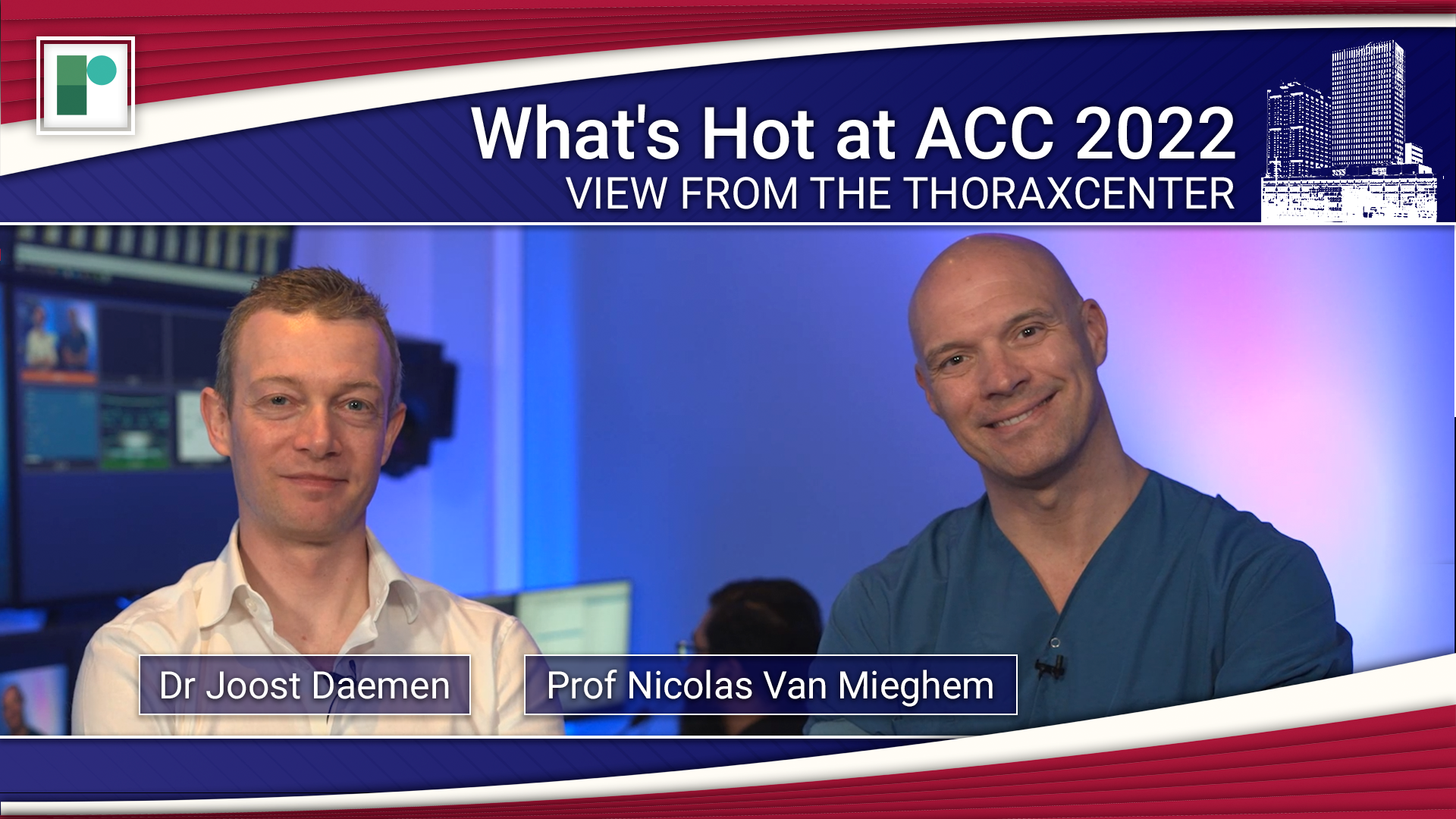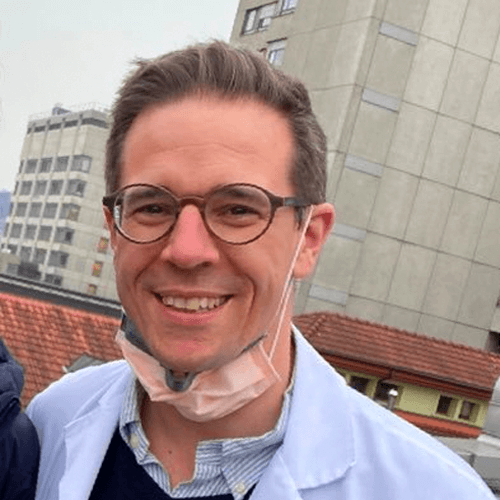ACC 2022: Late-breaking Science Video Collection
Published: 05 April 2022
-
Views:
 7932
7932
-
Likes:
 7
7
-
Views:
 7932
7932
-
Likes:
 7
7
-
 Up Next
Up Next -
 3m 31sPart 3 | Session 9 ACC 22: Magnitude & Duration of Effects of a siRNA Targeting Lp(a)
3m 31sPart 3 | Session 9 ACC 22: Magnitude & Duration of Effects of a siRNA Targeting Lp(a) -
 4m 48sPart 3 | Session 10 ACC 22: Results From a sub-study of the POISE-3 Trial
4m 48sPart 3 | Session 10 ACC 22: Results From a sub-study of the POISE-3 Trial -
 2m 55sPart 3 | Session 11 ACC 22: Findings from the CoreValve US Pivotal & SURTAVI Trials
2m 55sPart 3 | Session 11 ACC 22: Findings from the CoreValve US Pivotal & SURTAVI Trials -
 7m 44sPart 3 | Session 12 ACC 22: ADAPT-TAVR Shows SLT Does Not Affect CO for Patients After TAVR
7m 44sPart 3 | Session 12 ACC 22: ADAPT-TAVR Shows SLT Does Not Affect CO for Patients After TAVR -
 5m 41sPart 3 | Session 13 ACC 22: Results From the Chocolate-Touch Study
5m 41sPart 3 | Session 13 ACC 22: Results From the Chocolate-Touch Study -
 2m 25sPart 3 | Session 14 ACC 22: Results from the GIPS-IV Trial
2m 25sPart 3 | Session 14 ACC 22: Results from the GIPS-IV Trial -
 9m 27s
9m 27s -
 5m 35s
5m 35s -
 10m 24s
10m 24s -
 3m 50sPart 3 | Session 18 ACC 22: 3-year Efficacy Outcomes from the SPYRAL HTN-ON MED Med Pilot Study
3m 50sPart 3 | Session 18 ACC 22: 3-year Efficacy Outcomes from the SPYRAL HTN-ON MED Med Pilot Study -
 4mPart 3 | Session 19 2022 AHA/ACC/HFSA Guideline for HF Management: Highlights & Implementation
4mPart 3 | Session 19 2022 AHA/ACC/HFSA Guideline for HF Management: Highlights & Implementation
-
 12m 6sPart 4 | Session 1 ACC 22: 3 Trials That Will Change Your Practice with Dr Purvi Parwani
12m 6sPart 4 | Session 1 ACC 22: 3 Trials That Will Change Your Practice with Dr Purvi Parwani -
 6m 15s
6m 15s -
 7m 9sPart 4 | Session 3 4 Lipid Late-breaker Highlights from ACC.22 with Dr Erin Michos
7m 9sPart 4 | Session 3 4 Lipid Late-breaker Highlights from ACC.22 with Dr Erin Michos
-
 23m 9sPart 1 | Session 1 ACC 22 Late-breaking Science Preview Nicolas M Van Mieghem, Joost Daemen
23m 9sPart 1 | Session 1 ACC 22 Late-breaking Science Preview Nicolas M Van Mieghem, Joost Daemen
-
 28m 6sPart 1 | Session 2 ACC.22 Late-breaking Science Wrap-Up Nicolas M Van Mieghem, Joost Daemen
28m 6sPart 1 | Session 2 ACC.22 Late-breaking Science Wrap-Up Nicolas M Van Mieghem, Joost Daemen
-
 16m 42sPart 2 | Session 1 ACC 2022 Late-breaker Discussion: The SODIUM-HF Trial Justin Ezekowitz, Harriette Van Spall
16m 42sPart 2 | Session 1 ACC 2022 Late-breaker Discussion: The SODIUM-HF Trial Justin Ezekowitz, Harriette Van Spall
-
 16m 57sPart 2 | Session 2 ACC 2022 Late-breaker Discussion: The SuperWIN Trial Harriette Van Spall, Dylan L Steen
16m 57sPart 2 | Session 2 ACC 2022 Late-breaker Discussion: The SuperWIN Trial Harriette Van Spall, Dylan L Steen
-
 15m 38sPart 2 | Session 3 ACC 22 Late-breaker Discussion: The PROMPT-HF Trial Harriette Van Spall, Gregg C Fonarow, Tariq Ahmad
15m 38sPart 2 | Session 3 ACC 22 Late-breaker Discussion: The PROMPT-HF Trial Harriette Van Spall, Gregg C Fonarow, Tariq Ahmad
-
 22m 47sPart 2 | Session 4 ACC 22 Late-breaker Discussion: The DIAMOND Trial Harriette Van Spall, Javed Butler, Faiez Zannad
22m 47sPart 2 | Session 4 ACC 22 Late-breaker Discussion: The DIAMOND Trial Harriette Van Spall, Javed Butler, Faiez Zannad
-
 9m 38sPart 3 | Session 1 ACC 22: Findings from the VALOR-HCM Trial Milind Y Desai
9m 38sPart 3 | Session 1 ACC 22: Findings from the VALOR-HCM Trial Milind Y Desai
-
 7m 19sPart 3 | Session 2 ACC 22: MAVA-LTE Shows Improvement in NYHA Class in Patients Treated with Mavacamten Florian Rader
7m 19sPart 3 | Session 2 ACC 22: MAVA-LTE Shows Improvement in NYHA Class in Patients Treated with Mavacamten Florian Rader
-
 3m 19sPart 3 | Session 3 ACC 22: Results From the PACIFIC AF Trial Manesh R Patel
3m 19sPart 3 | Session 3 ACC 22: Results From the PACIFIC AF Trial Manesh R Patel
-
 3m 6sPart 3 | Session 4 ACC 22: FAME 3 Suggests CABG Outperforms FFR-Guided PCI in Patients with Multivessel Disease Frederik Zimmermann
3m 6sPart 3 | Session 4 ACC 22: FAME 3 Suggests CABG Outperforms FFR-Guided PCI in Patients with Multivessel Disease Frederik Zimmermann
-
 3m 54sPart 3 | Session 5 ACC 22: Results from the TRANSLATE-TIMI 70 Trial Brian Bergmark
3m 54sPart 3 | Session 5 ACC 22: Results from the TRANSLATE-TIMI 70 Trial Brian Bergmark
-
 4m 22sPart 3 | Session 6 ACC 22: Results from the POISE-3 Trial Philip J Devereaux
4m 22sPart 3 | Session 6 ACC 22: Results from the POISE-3 Trial Philip J Devereaux
-
 6m 30sPart 3 | Session 7 ACC 22: ICD Shock Therapies and the Burden of Ventricular Tachycardia Paolo Della Bella
6m 30sPart 3 | Session 7 ACC 22: ICD Shock Therapies and the Burden of Ventricular Tachycardia Paolo Della Bella
Overview
Our regular review series View from the Thoraxcenter hosted by Prof Nicolas Van Mieghem and Dr Joost Daemen (Thoraxcentre, Erasmus MC, Rotterdam, NL) provide a concise analysis of the late-breaking science results and spotlight impactful data.
For a deeper dive into key clinical trial data, Dr Harriette Van Spall (McMaster University, Hamilton, CA)talks with principal investigators in her regular Late-Breaker Discussion Series.
Short, accessible Expert Interviews were conducted with select faculty focusing on the results, applicability, and impact on future research.
More from this programme
Part 1
View from the Thoraxcenter
Part 2
Late-breaker Discussion Series
Part 3
Expert Interviews
Faculty Biographies

Lorenz Räber
Dr Lorenz Räber is an interventional cardiologist at Bern University Hospital, Bern, Switzerland. His research focuses on coronary heart disease, optical coherence tomography and infrared spectroscopy.
Transcript
Importance of this Trial
The trial is asking the question whether vulnerable plaques that are responsible for myocardial infarction, or sudden cardiac death in a large proportion, whether we can ameliorate those plaques by high-intensity lipid lowering with the use of alirocumab on top of high-intensity statin therapy.
Study Design and Patient Cohort
We enrolled a total of 300 patients presenting with either non-STEMI or STEMI. They were treated in their culprit lesion with a stent and, if they had non-obstructive disease in the two non-infarct related vessels, we imaged them using intracoronary imaging consisting of three techniques. First, with the combined catheter using intravascular ultrasound and near-infrared spectroscopy, those two catheters can assess the plaque burden and the lipid pool, both important vulnerability characteristics and the second catheter we used for intracoronary imaging is optical coherence tomography, which is a high-precision method that allows to measure the fibrous cap thickness, which is again an important vulnerability characteristic. Patients, after the imaging, were then randomly allocated to receive either alirocumab, 150 milligrams biweekly on top of high-intensity statin therapy consisting of Rosuvastatin, 20 milligrams daily or placebo biweekly on top of Rosuvastatin, 20 milligrams. After 52 weeks, patients underwent again, the same intracoronary imaging procedures using IVUS, NIRS and OCT at exactly the same localisation.
Outcomes of this Study
We have shown that alirocumab on top of high-intensity statin therapy, as compared to placebo on top of high-intensity statin therapy, reduces significantly percent atheroma volume, which is a measure of the plaque burden. It was reduced 2.1% in the alirocumab group and 0.9% in the placebo and statin group. On top of that, we provided data and evidence on a significant reduction in the lipid content of the plaques and of a significant fibrous cap thickening. Altogether, this provides evidence that alirocumab, initiated early in patients with acute coronary syndrome, can lead to plaque regression, delipification and stabilisation.
Take-home Messages for Clinicians
We also assessed a correlation between the on-treatment LDL and the reduction in the vulnerability markers like plaque burden, lipid content and fibrous cap thickness. And interestingly, when we achieved LDL levels below 50 milligrams per decilitre, the reduction in plaque volume and lipid content and the thickening of the fibrous cap was achieving the highest values. Therefore, the conclusion really is that the lower you get your LDL-C in this very high-risk population, the more regression, the more delipification and the more stabilisation you achieve in untreated non-obstructive lesions with vulnerability characteristics that potentially could lead, in the future, to myocardial infarction or coronary death.
Further Study Needed
Well, this is a mechanistic study providing evidence for the benefit of an early administration of a PCSK9 inhibitor, alirocumab, the early setting of ACS and that with that regimen you achieve plaque regression and stabilisation. However, what the potential next step should be is a clinical trial that actually investigates to which degree clinical outcomes can be reduced by such a treatment regimen. I would like to make you aware of one specific design feature of the PACMAN-AMI trial and that is the entry criteria with respect of the LDL-C. Most patients did not receive a statin at entry and their LDL had to be above 125 milligrams per decilitre, which is rather low. So therefore, the PACMAN-AMI really provides the grounds for a more aggressive and early LDL lowering, initiated in patients with high-risk characteristics.





